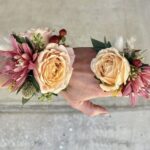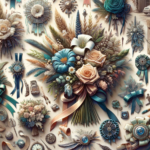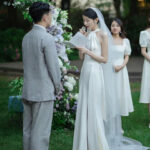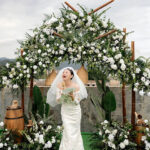Beautiful Plants For Your Interior

Weddings are moments of profound beauty, love, and exquisite details. Every element, no matter how subtle, contributes to the symphony of this special day. One of these delicate features, especially popular among brides, bridesmaids, and close family members, is the wrist corsage. These tiny flower arrangements may seem minute on the grand scale of a wedding, but they carry with them an essence of sophistication and tradition.
wrist corsages:
| Section | Sub-section/Details | Key Points |
|---|---|---|
| Historical Perspective | Origin of corsages | Ward off evil spirits, Symbolic meanings (love, purity, wishes) |
| Materials Needed | Flowers | Roses, orchids, calla lilies |
| Fillers | Baby’s breath, ferns | |
| Ribbon | Complementary to wedding colors | |
| Tools | Floral wire and tape, corsage wristband, scissors, wire cutters | |
| Crafting the Corsage | Flower Selection | Corsage as a reflection of a larger wedding canvas, the Importance of traditions |
| Preparation | Ensure freshness, Trim stems, Remove damaged petals | |
| Building the Base | Add filters around the main flower, Secure with floral tape | |
| Incorporate Fillers | Spray with water, Store in a cool place | |
| Personal Touches | Use ribbon, charms, pearls, rhinestones | |
| Final Touch | Corsage as a reflection of a larger wedding canvas, the Importance of traditions | |
| Tips for Longevity | Flower type | Opt for longer-lasting flowers |
| Floral preservative | Spray for moisture retention | |
| Avoid direct sunlight | Prevent premature wilting | |
| Wrist Corsage Etiquette | Traditional wearers | Mothers and grandmothers of the bride and groom |
| Modern trends | Bridesmaids, sisters, close friends | |
| Conclusion | Reflection on tradition | Corsage as a reflection of a larger wedding canvas, the Importance of traditions |
1. The Historical Perspective

The tradition of wearing flowers, particularly the corsage, is steeped in history and rich symbolism. To appreciate its role in today’s weddings, we must journey back through the annals of time.
Ancient Civilizations and Flowers
In ancient civilizations, flowers were not just an object of beauty but carried spiritual significance. The Greeks, for instance, believed flowers were linked to the gods and were used in many ceremonies to earn divine favor. The potent fragrances of certain flowers were believed to ward off malevolent spirits, and hence wearing them was a form of protection, especially during significant life events.
Medieval Europe and the Boutonnière
The tradition of wearing flowers can be traced back to medieval Europe, particularly with the boutonnière, a floral predecessor to the corsage. Knights would wear their lady’s colors – often in the form of a flower – as a sign of their commitment and to carry their beloved’s favor into battle. This romantic gesture signified love, honor, and devotion.
The Birth of the Corsage
The term “corsage” is derived from the French word “bouquet de corsage,” which means a bouquet for the bodice. Women of the 19th and early 20th centuries wore these floral arrangements pinned to their dresses. These corsages were popularized during formal events like dances and weddings. It was customary for a gentleman to gift his date a bouquet. As larger bouquets could be cumbersome, smaller arrangements, worn on the bodice, became the trend.
Over time, as fashion evolved, the corsage migrated from the bodice to the wrist, becoming more practical and allowing women to showcase their flowers without them being an impediment.
Symbolism and Modern Interpretation
The corsage’s symbolic connotations have also evolved. From a marker of protection against evil spirits to a symbol of romantic dedication, and now to a representation of celebration and honor in modern weddings. Today, the wrist corsage signifies respect and appreciation. Mothers and grandmothers, being the pillars of the family, wear them as badges of honor at weddings, linking generations through a beautiful floral tradition.

2. Getting Started: Materials You’ll Need
Starting a DIY project, especially for a significant event like a wedding, requires preparation and understanding of the materials involved. A wrist corsage, though petite, demands attention to detail. Let’s delve deeper into the materials you’ll need to craft a memorable piece.
1. Flowers:
- Choosing the Right Bloom: The central flower or flowers you choose set the tone for the corsage. Consider the color scheme of the wedding, the style of the dresses, and any themes or motifs being used.
- Size Matters: For wrist corsages, smaller blooms or a single larger bloom often work best due to the size constraint. Examples include mini roses, spray orchids, or a single calla lily.
2. Fillers:
- Texture and Volume: Fillers add depth and character to your corsage. They can soften the arrangement and make it appear fuller.
- Variety: From the feathery look of baby’s breath to the lacy appearance of ferns, there’s a vast array of fillers available. Consider other options like eucalyptus, heather, or even delicate berries.
3. Ribbon:
- Material: There are numerous types of ribbon, from satin to organza, each offering a unique finish. The choice of material can influence the corsage’s final look.
- Width and Length: Depending on whether you want a dainty bow or long, flowing tails, choose the ribbon’s width and length accordingly. A width of 1/4″ to 1/2″ is often ideal.
4. Floral Wire and Tape:
- Gauge Matters: Floral wire comes in different gauges or thicknesses. A medium gauge, like 22-26, is typically versatile for corsages.
- Tape Types: Floral tape is designed to stick when stretched. It comes in various colors, but green is commonly used as it blends seamlessly with most stems.
5. Corsage Wristband:
- Traditional vs. Modern: The classic elastic wristband is always an option, but there are now decorative wristbands adorned with pearls, rhinestones, or lace for added flair.
- Comfort: Ensure the wristband is adjustable and won’t pinch or be too tight. After all, it’ll be worn for several hours.
6. Scissors and Wire Cutters:
- Precision: Sharp floral scissors will give a clean cut, ensuring the stems aren’t crushed, which can hinder water absorption.
- Safety: Wire cutters are essential to trim floral wire without damaging your regular scissors.
7. Additional Adornments (Optional): For those looking to add a touch of luxury or personalization:
- Charms: Maybe the bride and groom have a special symbol or shared memory. A small charm can be added to represent this.
- Pearls or Rhinestones: These can be wired into the corsage for added sparkle and elegance.

3. Step-by-Step Guide to Crafting the Perfect Wrist Corsage
- Flower Selection: The heart of your corsage is the flower. Consider the bride’s bouquet, wedding colors, and overall theme. While a single flower can be the star, using a couple of smaller blooms adds variety.
- Preparation: Ensure your flowers are fresh. Trim the stems, leaving about 1-2 inches. Remove any damaged petals.
- Building the Base: Place your main flower or flowers on the corsage wristband. Secure with floral wire. The key is to ensure it’s snug but not overly tight. Remember, it’s going to be worn, and comfort is paramount.
- Incorporate Fillers: Gently insert your chosen fillers around the main flower, creating a halo effect or adding them to the sides for a balanced look. Use floral tape to secure them.
- Add Personal Touches: This is where the ribbon comes in. Tie it around the base of the flowers or let it dangle elegantly, based on your preference. Some even opt for adding small charms, pearls, or rhinestones for extra sparkle.
- Final Touch: Once you’re satisfied with the design, give it a gentle spray with water. This ensures freshness. Store the corsage in a cool place until it’s time to wear it.
4. Tips for a Long-lasting Wrist Corsage
A wrist corsage, though small, can make a big statement at a wedding or special event. Yet, its delicate nature means it’s susceptible to wilting or damage. Whether you’re a bride-to-be, a wedding planner, or simply attending a significant occasion, ensuring the longevity of a wrist corsage is crucial. Let’s delve into more detailed tips to keep that corsage looking fresh and vibrant.
1. Selection of Sturdy Flowers: While the choice of flower often depends on personal preference or the theme of the wedding, it’s wise to opt for blooms known for their durability. Flowers like orchids, roses, and alstroemeria are popular choices due to their longevity when cut.
2. Hydration is Key: Before assembling the corsage, soak flowers in a bucket of water for a few hours. This allows the blooms to absorb maximum moisture, which will be vital for their endurance. Additionally, consider using a floral hydration solution that provides nutrients and extends freshness.
3. Use Floral Foam: Incorporate a small piece of wet floral foam into your wrist corsage design. This can act as a tiny reservoir, providing water to the flowers and ensuring they stay hydrated throughout the event.
4. Proper Storage: Post-assembly and before wearing, store the corsage in a cool, humidified place, like a refrigerator (away from fruits and vegetables). This cold environment will slow down the aging process of the flowers and keep them crisp. However, avoid freezing temperatures, as these can damage the petals.
5. Minimize Handling: Each time the corsage is touched or adjusted, there’s a risk of bruising the flowers or breaking stems. Once it’s on, try to handle it as little as possible.
6. Protect from External Elements: If you’re attending an outdoor event, be mindful of the weather. Direct sunlight can cause flowers to wilt, while strong winds might damage them. Use a protective cover or shield if you anticipate being outside for extended periods.
7. Seal the Petals: Using a floral sealant spray can lock in moisture and prevent the petals from drying out. It forms a thin, transparent layer on the flowers, extending their freshness.
8. Opt for Silk Flowers: If longevity is a primary concern, especially in challenging environments, consider silk or faux flowers. They can be just as beautiful as real ones and will undoubtedly last the entire event without wilting.

5. Wrist Corsage Etiquette in Weddings
The wrist corsage, a delicate and beautiful adornment, is steeped in tradition and symbolism, especially when it comes to weddings. While many wedding customs have evolved over the years, certain etiquettes remain revered. Let’s delve into the nuances of wrist corsage etiquette in the context of weddings.
1. Traditional Wearers: Historically, wrist corsages were primarily reserved for special female members of the wedding party. This typically included:
- Mothers of the Bride and Groom: As key figures in the union of two families, it’s customary for them to don corsages to signify their importance.
- Grandmothers: Often, grandmothers of both the bride and groom also wear corsages as a sign of respect and recognition of their vital roles in the family lineage.
2. Modern Evolution: Today, the rules have loosened, and the list of potential corsage wearers has expanded:
- Bridesmaids: While they traditionally have bouquets, some contemporary weddings opt for wrist corsages for bridesmaids, especially for more intimate or low-key ceremonies.
- Sisters and Close Friends: Even if they aren’t part of the official wedding party, close female friends or siblings of the bride or groom might be honored with a corsage.
- Officiant: If the officiant is a close family friend or a relative, it’s not uncommon for them to wear a corsage or boutonnière.
3. Matching the Theme: The corsage should ideally complement the colors and theme of the wedding. It doesn’t need to be an exact match to the bride’s bouquet but should be in harmony with the overall floral design.
4. Placement and Wearing: Traditionally, corsages were pinned to the left side of a woman’s dress or blouse. However, with the evolution of fashion and practicality, wrist corsages became popular. They’re typically worn on the left wrist, but there’s no strict rule; they can be worn on whichever wrist the wearer finds comfortable.
5. Gifting Etiquette: It’s a thoughtful gesture for the bride and groom to present the corsage to the wearers, often during the rehearsal dinner or on the morning of the wedding. This act signifies appreciation and the special role that person plays in their lives.
6. Opting Out: If someone doesn’t feel comfortable wearing a corsage or has allergies, it’s essential to respect their wishes. Alternative tokens of appreciation or recognition can be offered, such as a special piece of jewelry.
7. Preservation: After the wedding, it’s polite to inform wearers that they can preserve their corsages by drying or pressing them, allowing them a keepsake to remember the day.

In Conclusion
Creating a wrist corsage is an art, a tiny reflection of the larger canvas that is the wedding. Whether you opt to DIY or work with a professional florist, ensure that the corsage resonates with the wedding’s theme and the wearer’s personality.
Remember, it’s not just about the flowers; it’s about the memories that bloom from such intricate details. As you embark on arranging the perfect wrist corsage, know that you’re participating in a tradition that has brought beauty and meaning to weddings for generations.



